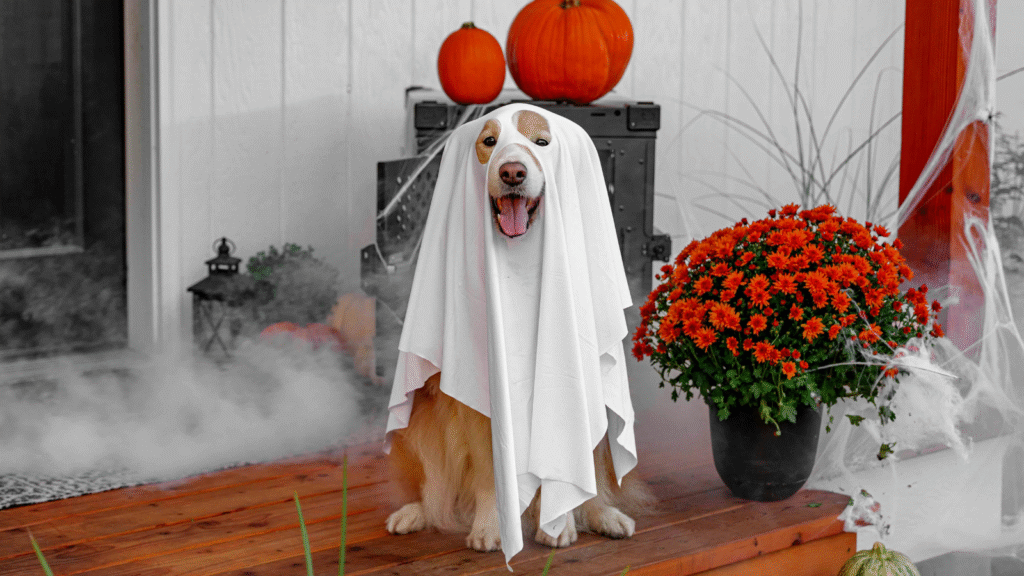From excited trick-or-treaters to costumes, doorbells, and flashing lights, Halloween can be a sensory overload for our pets. What’s festive for us can feel chaotic or even frightening to dogs and cats. Heritage Animal Clinic loves a good Halloween celebration, but we also know how easily this holiday can turn stressful for your furry companions. Here’s how to prepare your pet so the only scares this October are the fun kind.
Halloween Can Be Stressful for Pets
Costumed strangers, frequent knocks at the door, and unpredictable noises can confuse or overwhelm pets, especially those already prone to anxiety. Dogs may bark excessively, attempt to bolt, or even display fearful aggression, while cats may hide or show signs of stress like pacing or vocalizing. Understanding your pet’s stress triggers helps you prepare better and avoid behavior issues or potential emergencies.
As much as we love the idea of pets in costumes or joining in the fun, not every pet enjoys the spotlight. If your pet is shy, reactive, elderly, or just doesn’t do well with noise and crowds, it’s okay (and often safer) to let them skip the Halloween festivities entirely.
Seven Ways to Keep Your Pet Calm and Safe on Halloween Night
Step 1. Create a Calm, Secure Space for Your Pet
Set up a quiet room away from the front door with your pet’s bed, toys, and calming music. This gives them a place to relax during the commotion of visitors. Close curtains to reduce visual stimuli.
Step 2. Have Outdoor Cats Stay Home
Foot traffic and car traffic can be high on the night of Halloween, which means more chances that your cat could be involved in some kind of accident. Consider keeping your usually outdoor cat home starting in the late afternoon/evening.
Step 3. Keep Pets Away from the Front Door
The repeated opening and closing of the door is an escape risk, especially for pets who are curious or anxious. Use baby gates or keep your pet on a leash when greeting trick-or-treaters if they’re nearby. Better yet, consider keeping them confined to their calm space until the rush is over.
Step 4. Practice with the Doorbell (If Needed)
If your dog reacts strongly to the doorbell, spend the days leading up to Halloween desensitizing them with controlled training sessions. Offer treats and praise for calm behavior.
Step 5. Update ID Tags and Microchips
Even indoor pets can dart out unexpectedly when spooked. Before Halloween, double-check that your pet’s ID tags are readable and that their microchip is up to date, just in case.
Step 6. Watch for Costume Reactions
Kids (and adults!) in costumes can look frightening to pets, especially if they involve masks, hats, or props. Supervise interactions closely and remind children not to approach pets too quickly or loudly. If your pet is fearful, it’s best to keep them out of the action entirely.
Step 7. Keep Halloween Candy Out of Reach
Chocolate, xylitol (found in sugar-free gum and candies), and certain other sweet treats are highly toxic to pets. Dogs and cats are often curious and may sniff out unattended candy bowls or trick-or-treat bags. Make sure all Halloween treats are stored in closed containers and kept well out of reach, and remind kids not to share with their animal companions.
Bonus Tips
- Use calming sprays or diffusers
- Offer frozen Kong toys or slow feeders to keep dogs busy
- Use white noise machines or relaxing music to mask the chaos
- Consider scheduling a wellness visit to talk to a vet about calming supplements or medications if your pet has a history of severe anxiety
Have a Safe Halloween with Your Pet in Madison, AL
Halloween should be fun for the whole family, and that includes your pets, too. With a little preparation, you can create a safe and calm space for your pet while still enjoying all the spooky fun. Heritage Animal Clinic protects your pet’s health all year long with preventive and sick care veterinary services for cats and dogs from Madison, Huntsville, Athens, and neighboring Alabama communities. Not sure how your pet will handle Halloween? Contact Heritage Animal Clinic for behavior guidance or calming support.



